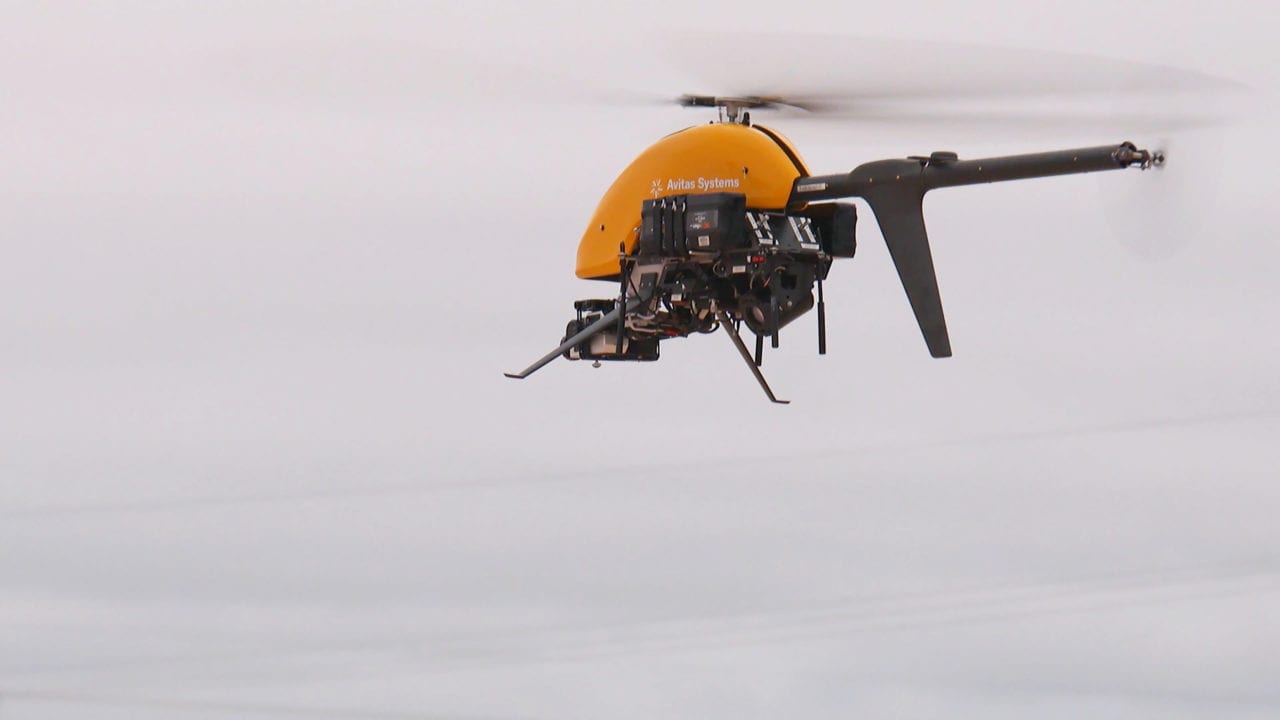
One of Avitas’ Vapor 55 drones operating in the Permian Basin
Avitas Systems, a GE venture, received the first FAA approval to fly a 55-plus-pound UAS beyond visual line of sight (BVLOS) with no spotter for commercial purposes. Operating on Shell oil facilities in the Permian Basin in part of Loving County, Texas, the company uses ground-based radar as its primary enabling technology.
Section 2210 of the FAA Extension, Safety, and Security Act of 2016 provides carve-outs to the Section 233 rules pertaining to large UAS use for “operations associated with critical infrastructure.” Through that avenue, said Avitas Director of Flight Operations Michael Clatworthy, the company was able to get the request it made to the FAA in March granted on Tuesday. Avitas is using its drones to inspect infrastructure—notably, well pads placed throughout challenging terrain—for the Shell Oil Company. In addition to faster, more efficient inspections through drone use, the company offers data fusion and interpretation using its machine learning algorithms.
The radar being used is a ground-based sense-and-avoid radar by DeTect Intelligent Sensors. “One of the keys is the radar really enabled us not to have human spotters on the pathway,” Avitas Interim CEO Brad Tomer said. Typically, flying beyond the operator’s line of sight still requires a human spotter to have eyes on the UAS on the grounds that reading technology alone is not reliable enough. But for Avitas’ purposes, required spotters would defeat much of the purpose of flying BVLOS in the first place.
Any pitch to the FAA for a rule exemption must make the case that the spirit of the rule will be satisfied through other means, ensuring safety. Avitas’ application used the radar system in conjunction with ADS-B, a high-performance GPS, point-of-view cameras the operator can look through and, according to the application filed with the FAA, “advanced flight control systems with a robust autopilot.” Avitas mounts these systems onto a Pulse Aerospace Vapor 55, bringing the normally 43-pound drone over the small-UAS limit of 55 lbs.
As important as the enabling technology is the risk mitigation inherent to the operation, according to Clatworthy.
“[The technology is] coupled with a strong operations safety case,” he said. “We’re not going out there asking any other aircraft to yield right-of-way to us.”
The company’s application detailed training for the flight operator and radar operator, area of operation and a plan to fly only during the day, all of which helped keep risks palatable to the FAA.
There have been other examples spotter-free BVLOS flight approval, but there is a crucial difference, Clatworthy said: They are approved to fly in certain places, but not use that flight to sell services or products.
“In Grand Forks (General Atomics’ test site in North Dakota), they go there because the area is approved, but I couldn’t go there and piggyback and charge Shell,” he said. “They can collect money for us to go and test, but they can’t go and test and turn it into a commercial delivery.”
Shell has an 80-point inspection of well sites that it sends people to go through a couple days a week, checking for things like liquid hydrocarbon and methane leaks as well as the condition of the equipment. Avitas can’t get through all 80 pieces yet, but that’s the goal. And if Shell inspectors only have to check a few things less frequently, and most of the more important things are being inspected by a drone with sensors that alert the operator if there’s an issue, that still saves time and money.
Currently, Avitas is approved for a 23.5 square mile area in west Texas. But the company sees potential for the same blueprint to be equally effective for any “horizontal asset” — one, such as a pipeline, that would benefit from the ability to continue flight beyond an operator’s line of sight. Tomer said it varies based on situation but Avitas pitches the ability to save a company 25% off its inspection time, and probably more.